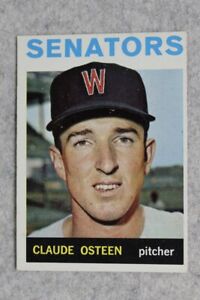Drafted by the Cincinnati Reds in 1957, lefthander Claude Osteen was traded to Washington for Dave Sisler in November 1961.
In November 1963, Gil Hodges told Ben Olan of the Associated Press that he had high hopes for the 24 year-old Osteen. “He has all the tools to be a 15-game winner for us,” Hodges said. “He has matured as a pitcher and with a little improvement could be a star. Osteen posted a 9-14 mark for last place Washington in 1963. “He hardly pitched at all for the first couple of months,” explained Hodges, who took over as the Nat’s manager on May 22 of that year. “Sid Hudson, our pitching coach, and I worked with him a lot and tried to build up his confidence. He has the right mental attitude now and should be a whole pitcher when he sharpens up his curve.” In 1963, Osteen did not win his first game l until June 11, when he shut out the New York Yankees, 1-0, defeating Jim Boston in Washington. He beat the Yankees again in Washington on August 6th. This time the loser was White Ford. Claude also shut out the hard hitting Boston Red Sox on five hits in Boston on Aug 30. He had 8 complete games, striking out 109 in 212 1/3 innings and walking only 59.
But in1964 Osteen made Hodges prediction come true, going 15-13 on a team that lost 100 games. Only Dick Bosman, who won 16 in 1970, won more games in a season in the history of the expansion Nats.
In December of 1964 the lefty was traded to the Los Angeles Dodgers along with infielder John Kennedy, Dick Nen, and $100,000 for Frank Howard, Ken McMullen, Phil Ortega, and Pete Richer.
“In the baseball business,” wrote Shirley Povich at the time, “Osteen’s kind is rarely for trading, especially by a team that must dip down to Buster Narum, a mere nine-game winner, for its next best starting pitcher. Into the decision by the Senators brass to trade off Osteen could be read brassy contempt for the tenet that pitching wins most ball games.”
Though traded, Osteen continued to make off season public appearances at Peoples Drug stores throughout the area along with pitcher Steve Ridzik and Coach Eddie Yost selling Christmas gift ticket packages to Senators games. He was urged to go through with the off season sales job by General Manager George Selkirk.
“We have to go for numbers,” explained Selkirk, “McMullen will give us a lot more versatility in the infield and everybody knows about Howard. He is still young enough and Gil Hodges and I think he is one of the most powerful hitters in the game. He gives us right handed power and that’s what we need.”
“We didn’t haggle at all,” said the Dodgers GM Buzzy Bavasi. “I had Howard on my untouchable list and Selkirk had Osteen on his. But the Lure of Osteen made me let go of Howard.”
“I’m joining a great pitching staff and I started thinking whether I was good enough to be part of them,” Osteen told Gregory Wolf of SABR in 2011, for the Biography Project. At Spring Training in Vero Beach, Florida, in 1965, new teammate Dick Tracewski dubbed him “Gomer” because he resembled Jim Nabors. But though he grew up playing baseball in rural Caney Springs, TN, Claude was no “Gomer.” “That Osteen is a serious fellow and a real pitcher,” Manager Walter Alston told “The Sporting News.”
In the 1965 World Series against the Minnesota Twins, Dodger Hall of Famers Don Drysdale and Sandy Koufax lost their respective starts in the first two games. Osteen was matched against former Senator favorite Camilo Pascual in game 3. “I was a nervous wreck,” said Claude. “But my teammates had confidence in me.” He pitched a shutout, nine brilliant innings, winning 4-0. It changed the momentum of the series. That was before a record Dodger Stadium crowd at the time of 55,934. Osteen never lost to the Twins, the original Washington Senators, in his days with the expansion Nats. Prior to the 1974 season, the Dodgers traded Osteen to the Houston Astros for outfielder Jimmy Winn. Wynn helped the Dodgers win the 1974 N.L. pennant. “I’m not sure which is more insulting, being offered in a trade or having it turned down,” said Osteen at the time. He need not have been insulted. His trades always brought value for value.
When he was released by the Cardinals in April of 1975, Osteen had 156 National League wins and 36 shutouts. Both marks were second only to Bob Gibson among active pitchers at the time. He won 20 games twice with the Dodgers and played in two World Series, posting an era of 0.86. He was a 3 time All-Star,
In his career, Osteen compiled 196 wins, 1,612 strikeouts, and a 3.30 earned run average. As a batter, Osteen had a .188 batting average with 8 home runs and 76 runs batted inches later became a pitching coach for the Cardinals, Philadelphia Phillies, and Texas Rangers.
In 1972, Osteen had an incredibly strong year finishing with 7 complete game victories in his last 9 starts. That year, he was 20-11 with a 2.64 ERA.
Osteen played his final game on September 27, 1975 with the White Sox.
Born on August 9, 1938, Claude Osteen is 74.







